Frederick Vodrey’s ceramic designs for the 1880s Dublin exhibitions
Published in 18th–19th - Century History, Features, Issue 2 (Mar/Apr 2005), Volume 13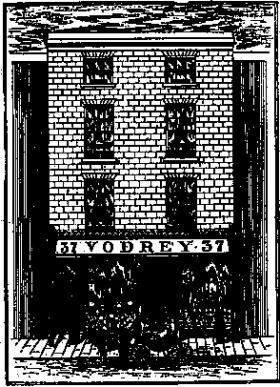
Sketch of Frederick Vodrey’s shop front, 37 Mary Street, from The industries of Dublin, c. 1880. (National Library of Ireland)
The ceramic designer Frederick Vodrey (1845–97) had a small pottery behind his warehouse in Moore Street and in 1880 opened a retail outlet in Mary Street. The shop is described in The industries of Dublin:
‘The pottery establishment of Mr Vodrey is the only representative firm in this line in Dublin that has upheld the name and the fame of the citizens in the ceramic art. Earthenware, faience, and porcelain may be seen in Mr Vodrey’s splendid shop and warerooms in Mary Street.’
The area of Henry Street and Mary Street in Dublin city was a busy shopping place, where retailers sold a wide range of goods for home decoration, such as wallpapers, furniture and ceramics. At that time Arnott’s had a separate retail outlet devoted entirely to the sale of china and earthenware at no. 50 Henry Street, situated across from the present-day Arnott’s, which was then, as it is today, a large department store. The area would have attracted custom from the many householders living in the newly built suburbs of Rathmines, Clontarf and Donnybrook. Whilst the clientele was undoubtedly from the privileged upper classes, there were a sizeable number of middle-class shoppers. The Henry Street district was an area of smaller, narrow streets and red-bricked terraced buildings. In the early nineteenth century this area was mostly residential, and several of the small terraced houses in Moore Street, for example, had formal ‘Georgian’-type gardens. However, by the later nineteenth century a busy commercial district had developed. Examination of the Ordnance Survey maps and Thom’s street directories show that by the 1860s the narrow streets housed a variety of retailers, from butchers and fishmongers in the Moore Street area to retailers of fashion accessories such as gloves and hats in the Henry Street area, interspersed with household furnishings.
Efforts to develop Irish industry
The success of Vodrey’s art pottery must be considered within the context of the many efforts that were made to develop Irish industry and utilise natural resources. In 1844 Sir Robert Kane’s report, The industrial resources of Ireland, was published. On the occasion of the Cork industrial exhibition in Ireland, John Francis Maguire’s book, The industrial movement, outlined the many exhibits and the ventures in various parts of Ireland to develop industries. It must be said that the term ‘industry’ applied mostly to craft-based projects such as lace and embroidery, which provided employment for girls and women, rather than the industrial development associated with England during the same period. In terms of the ceramic industry, the encouragement to develop natural resources led directly to the establishment of the Belleek factory in County Fermanagh in 1858. The landowner, Lord John Caulfield, joined with Robert Armstrong to provide local employment. The Dublin retailer David McBirney, who had a large store, ‘Hibernia House’, at Aston Quay, noted for the sale and export of Irish woollens and linens, was also a director. McBirney’s was known to be a retail outlet for Belleek in Dublin city. There were other retailers of Belleek, for example Callinan & Son at Grafton Street. Whyte and Company, which began as the sole agent for Waterford glass in the earlier nineteenth century, retailed Belleek wares, as well as both English and Continental china and earthenware, at their two premises in Marlborough Street and South Great George’s Street.
From the mid-nineteenth century industrial exhibitions were held in all the major cities—Berlin, Paris and London. The purpose of these was to exhibit and promote invention and industry. Three international exhibitions of this type were held in Dublin, in 1852, 1863 and 1872. All included exhibits from manufacturers abroad, which tended to overshadow the Irish exhibits. The 1872 ‘Dublin exhibition of arts, industries and manufactures’ was held in the Winter Palace and Garden, Earlsfort Terrace (now the National Concert Hall). Ceramics on display included Belleek exhibited by McBirney & Co. The factory had already gained success at the 1862 international exhibition in London, which was followed by a commission from Queen Victoria for a tea set. Frederick Vodrey’s art pottery had not yet made an appearance, although his mother, Agnes Vodrey, was already in the retail ceramic trade from c. 1861, with a warehouse at 19 Moore Street and a shop at 23 Henry Street. Frederick is recorded as taking over the lease of 19 Moore Street in 1875.
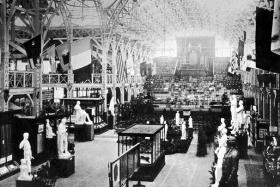
View of the interior of the 1882 National Exhibition. Note the ‘Irish banners and shields of the counties, provinces and towns of Ireland’ (detailed right) hanging on either side of the hall. (Trinity College, Dublin)
The Winter Palace and Garden had been built for the 1863 exhibition and was owned by several Dublin businessmen. The event was opened with great ceremony by Prince Edward, and a ball held the night before was quite a society affair. The lack of connection between the development of industry and commerce in Ireland and such an event (which showcased mainly Continental and British manufacturers) drew criticism. The exhibition was not a financial success, although it was advertised in England and rail and ferry transport provided to encourage visitors from across the sea. The interests of the court circle at Dublin Castle and the aristocracy dominated such an event to the exclusion of the cultural predilections of a growing merchant class who would have identified with a Gaelic heritage and would have been predominantly Catholic.
Frederick Vodrey’s background
However, Frederick Vodrey, from a family of potters in Stoke-on-Trent, England, may also be considered part of this emergent middle class. He married Annie Cuthbert, from an established merchant family with a business in Bray, Co. Wicklow. Annie’s mother was a retailer of china and earthenware. It is an interesting point that a significant number of china retailers in the Dublin area were women. It was probably considered a suitable and profitable business for women to enter, as most of their clients would have been women. Owing to the development of exports of ceramic goods to the United States, the Continent and the colonies, the agent and retailer played a significant role in the ceramic trade. For example, Frederick Vodrey is described as an ‘agent for Coalisland’, the pottery in County Tyrone. He was also described in the trade’s magazine, The Pottery Gazette, as a frequent and important buyer in the Staffordshire potteries district.
Perhaps encouraged by the Belleek display at the 1872 exhibition, Frederick Vodrey’s activities as a wholesaler and retailer in the Henry Street/Mary Street area of Dublin city expanded to include the manufacture of art pottery c. 1873, when he collaborated with Herbert Cooper, who taught classes at the Queen’s Institute, Molesworth Street. Porcelain-painting was taught as a useful skill for middle-class women who needed to earn a living. It is said that Vodrey fired the students’ pieces but that the partnership ended after a short time because of a disagreement with Cooper. Vodrey also fired ceramic pieces made by members of the Dublin Sketching Club.
After the brief collaboration with Cooper, Vodrey began to produce art pottery on his own behind his wholesale warehouse at 19 Moore Street. Moore Lane would have provided access for the unloading of raw materials and also for the transport of finished goods. He employed trained potters from Stoke-on-Trent, including his brother Thomas, who was a mould-maker. Frederick is always described as a designer in advertisements, although, to date, no sketchbook has emerged in the family archives. However, the designs produced by the small factory have the hallmarks of design principles taught by the south Kensington system in schools throughout England. There were several of these schools in the pottery district. It can be assumed that Frederick, as the son of a potter, began his training in one of the many potteries of Tunstall or Burslem at about the age of fifteen. This practical training in the factory system would have been supplemented by attendance of night classes at one of the mechanics institutes. Within the context of Dublin city, he may be considered as having had unusual skills appropriate to the running of a pottery. The designs that he produced, whilst being examples of the current trends in taste at the time, also display a unique flair for natural form and a willingness to experiment with glaze and colour, which was such a new aspect of ceramic production at this time. Vodrey’s design work was current with design trends, technically excellent, and unique in Dublin at this time.
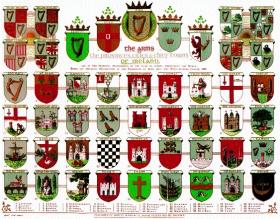 Celtic Revival
Celtic Revival
During the 1870s Dublin suffered as a result of the wider international economic decline, the effects of which continued into the 1880s. In response, there was a resurgence of interest in the development and promotion of Irish goods and industries. At the same time the debate over free trade versus protectionism was raging. Dublin commercial interests took different sides in the debate, evident in the papers given by members of the Dublin Statistical Society. Alongside this was the demand for Home Rule led by Charles Stewart Parnell and a corresponding interest in all aspects of the original Gaelic culture of the island. The wide range of design objects created as a result of this ‘Celtic Revival’ have been documented by the late Jeanne Sheehy in The rediscovery of Ireland’s past: the Celtic Revival 1830–1930, in which she details items such as silver reproductions of early Celtic jewellery and bog oak ornaments as well as ceramics from the Belleek factory and furniture exhibited as early as the Great Exhibition held in 1851 at Crystal Palace in London.
Frederick Vodrey’s designs adapted to the current changes in taste and the growing interest in Gaelic culture. His work was first exhibited at the 1882 Dublin National Exhibition. The venue was at the top of the main thoroughfare, Sackville Street (now O’Connell Street). The opening of the 1882 exhibition coincided with the unveiling of a statue of O’Connell at the lower end. Notices in the Freeman’s Journal advised those attending to arrive early in order to get seating at the unveiling before proceeding on to the exhibition opening further up the street.
Greater Catholic and nationalist associations
Clearly this exhibition, unlike the previous 1872 one, had associations with nationalist and Catholic opinions. It is also known that Parnell’s sisters raised funds for it. Commerce in some quarters was becoming closely entwined with political ideology. The city council at the time was dominated by Catholics—a significant change from earlier years—owing to the widening of the franchise to include smaller property-owners. The illustrated guide to the exhibition reveals some interesting images. For example, a view of the interior shows Irish banners and shields of the counties, provinces and towns of Ireland and of Irish communities abroad in Scotland, Canada, and Australia. These banners were an important statement of a unified identity. They sought to answer or rebut the tradition of royal ceremony and the heraldic imagery of the now-disestablished Anglican Church. Such banners were a significant commodity in nineteenth-century Ireland. They were produced in quantities for religious societies and nationalist fraternities.
Frederick Vodrey’s pottery was exhibited in the materials section of the 1882 exhibition held in the Rotunda grounds. There were samples of clays from different parts of Ireland and he won a prize for pottery made from Irish clays. There is nothing to suggest that the designs were in any way Celtic at this point. In fact, a piece dated 1882 in the National Museum and others suggest that the style of the items produced by the Vodrey factory at this time was more ‘high Victorian’, using elements of the Classical Revival taste. However, the pottery was soon to produce many designs with Celtic-style ornament and wares that may be considered icons of the Celtic Revival period. For these designs Frederick Vodrey collaborated with the painter Charles Russell. A sketchbook of Russell’s, now in the National Museum, is filled with detailed drawings of Celtic spiral and zoomorphic ornament. Several of these were preparatory designs for the small hand-painted pot shown on p. 32. It is inscribed underneath ‘C. Russell pinxii 6-11-85’ and impressed with the pottery mark ‘Dublin Pottery Vodrey’. The Dublin Sketching Club, of which Russell was a member, advertised a Christmas exhibition of ‘artistic pottery’ in the Irish Times on 5 December 1882. Given that the words ‘Bliain Sona Duit’ (Happy New Year) are painted on this vase, it is likely that it was made for a subsequent annual exhibition in 1885.
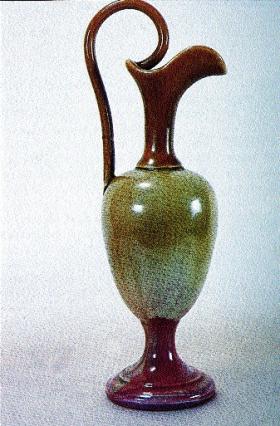
Ewer, c. 1882, impressed on base ‘Dublin Pottery’. (National Museum of Ireland)
The Vodrey pottery also produced large jardinières (plant-holders), a standard item of Victorian interior decoration. Most of these were moulded with Celtic interlace decoration. There are some typical examples on display in the National Museum. Such objects of design produced in later nineteenth-century Dublin must be considered within the context of commercial and cultural politics at this time. The Celtic Revival and growing nationalist ideology would have influenced Vodrey’s production. He consistently advertised that his pottery was made of Irish clays, an important selling point. Evidence suggests that the cream-coloured ceramic body most commonly identified on the items produced at the factory possibly came from Coalisland. There is also evidence to suggest that a white clay from Knockcroghery, Co. Roscommon, was used. From c. 1860 the architectural magazine The Irish Builder published many articles on the discovery and preservation of Early Christian churches and studies in the Irish language.
However, there is also a wider international context for the revival of Celtic culture in late nineteenth-century Dublin. Since Owen Jones published The grammar of ornament in 1856 Celtic ornament had been popularised, along with a wide range of different styles from Moorish to classical. Various types of ornament from many cultures became the ‘stock-in-trade’ or part of the vocabulary of the Victorian designer in Britain and elsewhere. Given his design school education in England, Frederick Vodrey would have been well versed in different types of ornament. Examples of other designers who based their design work on Celtic sources included the Scot Archibald Knox, who designed a range of silver known as ‘cymric’ ware for the Liberty shop in London. It is evident from the drawings and slight notes in Russell’s sketchbook that he and Vodrey were also well aware of contemporary colour theory as they make note of Ogden Rood’s writings on the subject. The mixing of the intense colours in the small vase painted by Russell is evidence of this, as is Vodrey’s later achievement of intensely coloured glazes that were highly praised when he exhibited at the 1885 Artisan’s Exhibition in Dublin, held in the South City Markets on George’s Street.
An article in the Dublin University Review by Howard Pentland praises the ‘Vodrian ware’ on display at the 1885 exhibition:
‘One of the first impressions during a view of the Vodrian ware is the excellence of the colours. Those obtained are a ruby red, olive green, brown, orange, and yellow. Its strength lies in the red, which is vastly superior to Wemyss in tone, and differs only from Linthorpe in the absence of slight crackle usually to be observed in the latter. The yellow is very good, but rather light in tone and not quite equal to that used at Wemyss, while the orange is a trifle thick and muddy. The green is a great success, and while much clearer and brighter than the stock olive, is entirely free from that crudeness, the fear of which has flooded us with a tint approaching that of Liffey mud.’
Pentland judges Vodrey’s pottery within the context of other art potteries in England and discusses the influence of Japanese art that was prevalent at the time. Clearly the products of Vodrey’s Dublin pottery were regarded as equal to other contemporary potteries in Britain and France. Pentland encourages further development of the commercial enterprise to cater for the contemporary design taste:
‘The promoters of this pottery should now endeavour to produce in perfection those articles such as jardinières, which are at present in vogue, keeping in view that their function is to hold flower pots of the current dimensions, and bearing in mind that it is often desirable, especially in the coming months of chrysanthemum bloom, to bring into the house pots up to ten inches in diameter. A few efforts of this kind will tend to reduce the percentage of rubbish, and gradually prepare the way for the adoption of a regenerated domestic pottery. With a ware of a naturally beautiful tint and glaze, that may be made to vary in red, green, yellow, blue, and metallic lustre, from tints as light as the ware itself to any desired depths, there is no bourne to our success.’
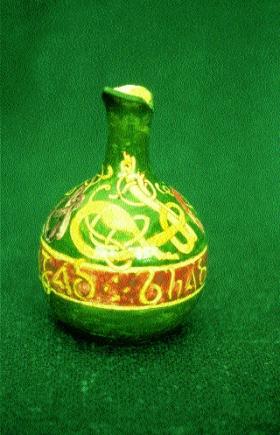
Hand-painted vase with zoomorphic and Celtic spiral decoration, inscribed C. RUSSELL PINXII 6-11-85 and impressed ‘Vodrey Dublin Pottery’. (National Museum of Ireland)
It is interesting that Vodrey advertises frequently in the Dublin University Review during this period. It would appear that he wanted to cultivate a clientele amongst the middle-class professionals and academics of Trinity College who would have read the journal. It also suggests that the purchase of Vodrey’s art pottery was considered an aspect of cultured taste in Dublin during the 1880s. The advertisements detail the favourable reports and prizes won at the earlier Cork Exhibition in 1883:
‘This attempt to produce an ornamental faience in Ireland, and the perseverance with which Mr Vodrey worked out his idea deserves every success, and accordingly he is awarded a medal’.
Pentland’s article is illustrated with a sketch of four items of pottery, all of which appear to be decorated with Celtic ornament. One of these designs is similar to one of the pots in the National Museum collection. However, examples of the other three designs have not yet come to light. As Vodrey’s pottery was frequently made in the mould, it is likely that there is more than one example of these designs.
1885 exhibition
Vodrey’s pottery is listed at no. 55 as ‘Potter’s wheel at work; artistic and domestic pottery. F. Vodrey, Dublin’ in the exhibition catalogue. There are nine workmen listed as demonstrating, including Frederick himself as ‘designer and manufacturer; William Lucas, thrower (potter on the wheel); Patrick Slevin, presser and mould-maker; Mary Anne Carr, painting and glazing; Jane Norman, assistant; T. Vodrey, pressing and casting; William Norman, fireman; William Norman jun., and P. Buckley jun., thrower’s assistants’. T. Vodrey was probably Thomas, Frederick’s brother. Clearly this was quite a small venture when compared with the Belleek pottery, which exhibited in the same section and which, in contrast, had 51 workmen (including twenty decorating and fifteen firing).
The Celtic designs produced by the Vodrey pottery and exhibited at the Dublin Sketching Club exhibition and the Dublin Artisan’s Exhibition may be regarded as significant icons of cultural nationalism, which had its focus in Home Rule politics. The pottery designs reflect the Celtic Revival taste and demonstrate the aim of developing industry through the use of natural clay resources in Ireland at this time. The national exhibition held in 1882 demonstrated a shift in the balance of power in Dublin politics. It was supported by Dublin businessmen, and newspaper articles urged the public to give patriotic support. In contrast to the 1872 exhibition, the two exhibitions of art and industry held in Dublin in the 1880s aimed to showcase and encourage Irish industry, as opposed to the more international exhibitions of earlier years. However, given Vodrey’s British design education, the Celtic designs produced by his Dublin pottery must also be considered within the wider context of revivalist taste in Britain and Europe during this period.
Aisling Molloy is a postgraduate student at the Royal College of Art/Victoria and Albert Museum, London.
Further reading:
M. Daly, Dublin: the deposed capital 1860–1914 (Cork, 1984).
S. Durant, Ornament: a survey of decoration since 1830 (Macdonald, 1986).
J. Hutchinson, The dynamics of cultural nationalism: the Gaelic Revival and the creation of the Irish nation state (London, 1987).
P. Larmour, The Arts and Crafts movement in Ireland (Belfast, 1997).
















